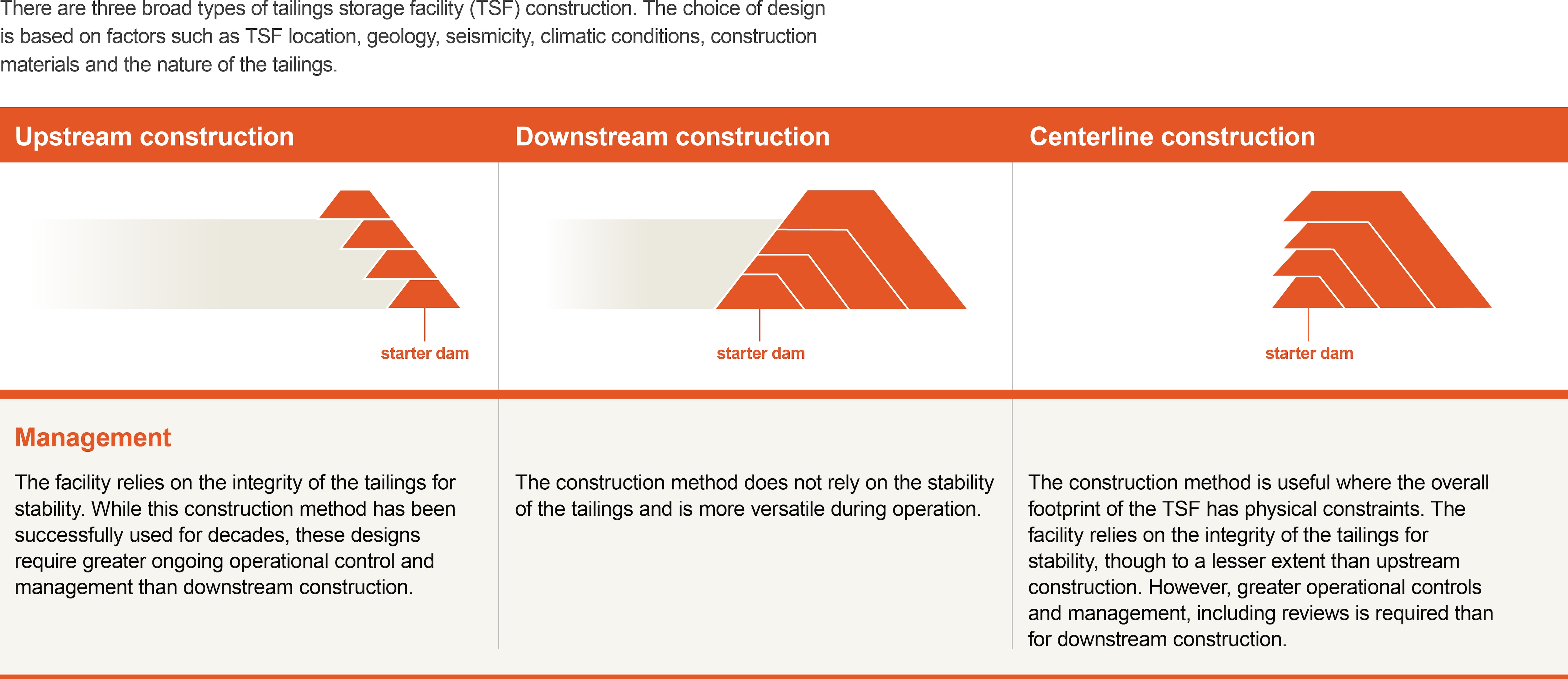Tailings are the left-over materials from the processing of mined ore. They consist of ground rock, unrecoverable and uneconomic metals, chemicals, organic matter and effluent from the process used to extract the desired products from the ore.
Tailings are stored in tailings storage facilities (TSFs). TSFs are dynamic structures that accommodate the leftover materials from the processing of mined ore.
There are different types of TSFs:
- surface facilities, including paddock style or valley fills, which can comprise multiple dams (or cells) that have continuous, structurally similar interconnected walls
- in-pit facilities
- dry stack facilities
How do TSFs differ from conventional water dams?
The principal difference between TSFs and conventional water dams is that TSFs are constructed to maintain storage of waste material produced during mining operations, whereas water dams are typically built to store and release water. Also, TSFs are dynamic structures that often grow over the life of the mine to accommodate increasing tailings volume whereas water dams are typically erected in a single phase of work. The construction materials can also differ. TSFs are usually constructed from earth and rock waste materials from the mine, whereas water dams can be constructed from earth, rock, concrete and other materials.
Tailing storage facilities
There are three broad types of TSF construction, which are depicted below. The design choice is based on factors, including:
- TSF location
- site conditions (geology, seismicity, climatic conditions)
- construction materials
- tailings characteristics
Types of tailings storage facilities

Maintaining TSF integrity requires ongoing focus on appropriate engineering design, quality construction, ongoing operating discipline, maintenance, effective governance and independent reviews. In addition to design choice factors, internal and external factors that can influence TSF integrity include:
- quality assurance and quality control of TSF construction
- maintaining TSF operating discipline, including tailings characteristics, water management, monitoring and consideration of changes to any of these factors
Lifecycle of tailings storage facilities
TSFs evolve over their lifecycle, from planning, design, construction, operations, closure and ultimately to post closure. There may also be periods of care and maintenance between operational phases.

The duration of the closure phase in a TSF’s lifecycle can exceed the duration of the operational phase. The closure phase may include transition from operations to active care when tailings deposition ceases. Active care typically includes a continuation of water, geochemical and physical management processes that are designed to maintain TSF integrity. Over time, inactive TSFs may transition to passive care when the ongoing water, geochemical and physical management requirements are reduced or eliminated. Once a TSF has transitioned to passive care, additional works may be carried out to rehabilitate the site, such as earthworks and re-vegetation.
Sustainability case studies, organisational boundary, definitions and disclaimers, and downloads
Prior year versions of some of the listed documents are available on the Past reports page.-
BHP Annual Report 2025
pdf
17068205

-
Sustainability reporting organisational boundary, definitions and disclaimers
pdf
170075

-
Límite organizativo de los informes de sostenibilidad, definiciones y descargos de responsabilidad
pdf
234993

-
BHP ESG Standards and Databook 2025
xlsx
2541694

-
BHP Group Modern Slavery Statement 2025
pdf
7308735

-
BHP GHG Emissions Calculation Methodology 2025
pdf
1124687

-
BHP Climate Transition Action Plan 2024, subject to updates of certain aspects of our assumptions and plans in the BHP Annual Report 2025, Operating and Financial Review 9.8 – Climate change
pdf
8480121

-
Global Industry Standard on Tailings Management - Public Disclosure 2025
pdf
25537144

-
Tailings Storage Facility Policy Statement 2023
pdf
73457

-
Case studies

